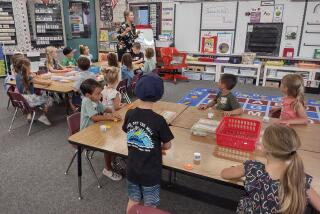Kindergarten Cutoff Date Sets Some Kids Up for Failure
- Share via
California recently started to rehabilitate its dilapidated school system. We implemented world-class standards and the STAR test (the Stanford 9) to measure our students’ progress. We have mandated the elimination of social promotion and are beginning once again to focus on reading, writing and arithmetic.
We now expect kindergartners to read and complete simple math problems by the time they enter first grade. Kindergarten is no longer the time that we remember, with games, songs and naps; it is now similar to first grade. Yet California’s children start kindergarten younger than those in most other states.
California allows children as young as 4 1/2 to enter kindergarten. This is because a child may enter school if he or she turns 5 by Dec. 2. At the same time, California has the most year-round schools in the nation that begin in July. Children with autumn birthdays often struggle with the rigors of the new academic kindergarten and are frequently placed in pre-first-grade classes, forced to repeat kindergarten or, in some cases, continue to perform poorly throughout school and even into adulthood.
This has little to do with how bright the child is, but studies have indicated that these children are generally not developmentally prepared to cope with formal school, which dramatically increases their chances for failure.
This is why I introduced legislation (AB90) that would change the kindergarten cutoff date from Dec. 2 to Sept. 1, ensuring that children are either 5 or close to 5 before entering. This measure would be phased in over four years to help parents, teachers and schools plan for the change.
Teachers across California have said for years that 4-year-olds are generally not prepared for an academic environment. An academic kindergarten includes activities like sitting for an extended period to write, listen and sound out words. Small motor skills are required for the kindergarten curriculum.
However, studies have indicated that most 4-year-olds are still mastering large motor skills, like running and climbing. These children are often defeated in their efforts, not because they lack intelligence but simply because they lack developmental readiness.
A recent study by Rochester General Hospital found that children young for their grade were twice as likely to have behavior problems and that boys young for their grade were six times as likely to be suspended. This makes perfect sense. The best way for a frustrated child to hide deficiencies is to act up or be the class clown.
A survey of approximately 25 California school districts recently demonstrated that 63% of children who repeat kindergarten have autumn birthdays. A 1991 report by the California Department of Education states that the cost for repeating kindergarten alone is $84 million. If the age to enter school were slightly older, fewer children would need to be retained and would be therefore more prepared to enter the next grade level.
Changing the kindergarten entrance date to Sept. 1 is not an extreme measure. California is one of only a handful of states with kindergarten cutoff dates as late as December.
Although changing the entrance age would help our children be better prepared for a structured school environment, this measure is by no means the entire solution to California’s school problems. Many factors besides chronological age contribute to learning readiness, including preschool, nutrition and a stimulating home environment. Implementing this measure, however, would help children with one factor that we know leads to academic success.
If fully implemented, this measure would generate approximately $600 million a year until the transition classes had graduated high school. This additional revenue would be given back to school districts proportionately to improve local schools.
Passage of this proposal would produce more successful children who would be better equipped for California’s rigorous new academic standards. We should not set our children up for failure but rather for success.
More to Read
Sign up for Essential California
The most important California stories and recommendations in your inbox every morning.
You may occasionally receive promotional content from the Los Angeles Times.










